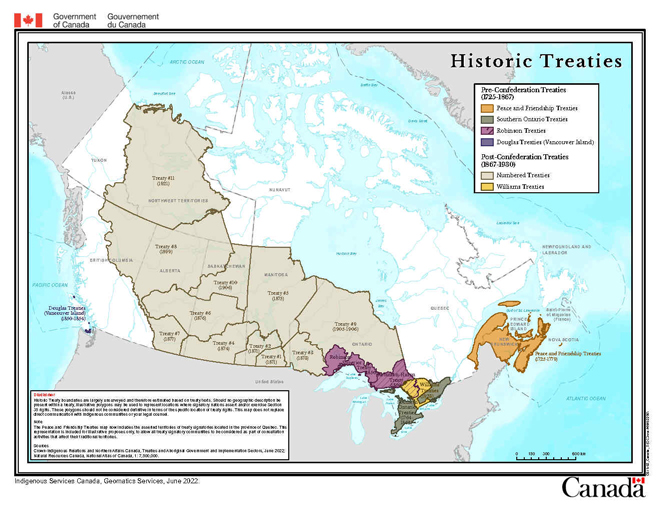Maps of Treaty-Making in Canada

Source: AANDC
The process of dealing with Aboriginal title and rights through formal agreements began shortly after contact was established between Europeans and First Nations peoples and has evolved over more than 300 years.
In this section, view maps illustrating the Pre-1975 Treaties of Canada, that were negotiated between 1725 and 1923. These treaties cover most of Ontario, the Prairie Provinces, parts of Vancouver Island, Northwest Territories and Atlantic Canada.
Map List
Pre-1975 Treaties of Canada (PDF, 1.58 Mb)
Map illustrating the Pre-1975 Treaties of Canada
Map of Canada in 1871 (PDF, 1.62 Mb)
Treaty No. 5. This treaty originated in two historical processes. The southern part, negotiated in 1875, was one of the southern Prairie treaties, and was in large part a result of the insistence of the Native people of that region that their Aboriginal rights be recognized by the Canadian government, which had recently acquired title to their lands. The northern part of Treaty 5 was negotiated in 1908.
Map of Canada in 1873 (PDF, 1.59 Mb)
Treaty No. 3. After three years of negotiations, the Dominion of Canada and the Saulteaux tribe of Ojibway Indians entered into treaty at the North-West Angle of the Lake of the Woods. With the Saulteaux surrendering title to an area of 14,245,000 hectares, Canada acquired land for agriculture, settlement and mineral discovery. More importantly, Canada secured communications with the North-West Territories, including the route of the future Canadian Pacific Railway.
In 1873, Prince Edward Island enters Confederation, bringing the number of provinces in the Dominion to seven.
Map showing Treaty No. 3
Map of part of the Dominion of Canada showing Treaty No. 3.
Map of Canada in 1874 (PDF, 1.61 Mb)
Treaty No. 4. Initiated by Indians and Métis concerned about the declining numbers of animals which provided them with a living. Treaty 4 covers present-day southern Saskatchewan. Provisional boundary set in northern Ontario.
Map of Canada in 1875 (PDF, 1.61 Mb)
Treaty No. 5. This treaty originated in two historical processes. The southern part, negotiated in 1875, was one of the southern Prairie treaties, and was in large part a result of the insistence of the Native people of that region that their Aboriginal rights be recognized by the Canadian government, which had recently acquired title to their lands. The northern part of Treaty 5 was negotiated in 1908.
Map of Canada in 1876 (PDF, 1.62 Mb)
Treaty No. 6 - The negotiation of this treaty took place during a difficult period for the Plains Cree, who were suffering from the rapid decline of the buffalo. The documents indicate that their concerns included medical care and relief in case of need.
Map of Canada in 1877 (PDF, 1.62 Mb)
Treaty No. 7. The last of the numbered treaties negotiated and signed during the 1870s. The treaty covers the southern part of present-day Alberta.
Treaty No. 8 area
Map showing the territory ceded under Treaty No. 8 and the Indian tribes.
Map of Canada in 1899 (PDF, 2.00 Mb)
Treaty No. 8. The first of the northern treaties covered an area of 324,900 sq miles and represents the most geographically extensive treaty activity undertaken. It comprises what is now the northern half of Alberta, the northeast quarter of British Columbia, the northwest corner of Saskatchewan, and the area south of Hay River and Great Slave Lake in the Northwest Territories.
Map of Canada in 1905 (PDF, 2.00 Mb)
Treaty No. 9. In response to continuous petitions from the Cree and Ojibwa people of northern Ontario, and in keeping with its policy of paving the way for settlement and development, the federal government in 1905-1906 negotiated Treaty 9, also known as the James Bay Treaty. For the first and only time, a provincial government took an active role in negotiations. Together with the area acquired by adhesions in 1929-1930, Treaty 9 covers almost two-thirds of the are that became northern Ontario.
In 1905, the provinces of Alberta and Saskatchewan are created.
Map of Canada in 1906 (PDF, 1.97 Mb)
Treaty No. 10 covers 220,000 square kilometres of northern Saskatchewan and Alberta. Unlike the land in southern Saskatchewan, the Treaty 10 lands were deemed unsuitable for agriculture and so the federal government did not respond to demands from the region's Native people for a treaty until the early 20th century, when the mixed-blood people of northern Saskatchewan began to demand compensation for loss of Aboriginal rights and the Provinces of Saskatchewan and Alberta had been created.
Map of Canada in 1921 (PDF, 2.11 Mb)
Treaty No. 11 was the last of the numbered treaties covers most of the Mackenzie District . The land in the area was deemed unsuitable for agriculture, so the federal government was reluctant to conclude treaties. Immediately following the discovery of oil at Fort Norman in 1920, however, the government moved to begin treaty negotiations.
Map of Canada in 1923 (PDF, 2.05 Mb)
Williams Treaties. Treaty-making activities along the north shore of Lake Ontario in 1783-84, variously known as the Toronto Purchase, the Carrying Place Purchase, the Crawford Purchases and the Gunshot Treaty, produced lingering uncertainties that are resolved in large part by the Chippewa and Mississauga Agreements negotiated in 1923.